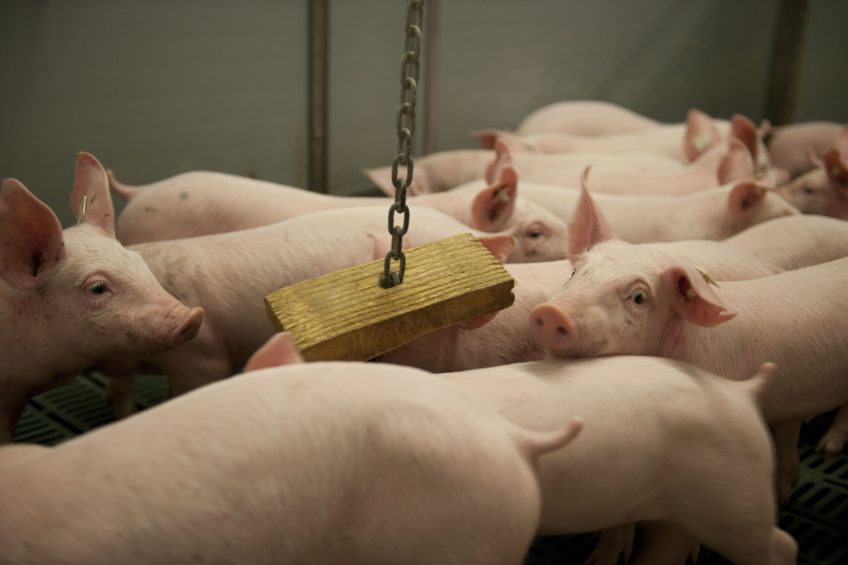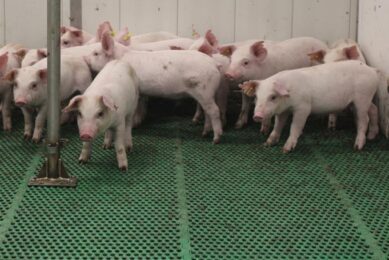Rehabilitation & repair of the gut microflora in pigs

A pig’s gut can work optimally when the total community of bacteria, fungi, protozoa and viruses is diverse and balanced. The usage of antibiotics can disturb that balance – so how to restore it as swiftly as possible?
An increase in food safety concerns resulting from extensive antibiotic use has seen the pig and poultry industries challenged in recent years, as meat free from antibiotics and disease has become a requirement within the EU. Consumer demand for antibiotic-free meat has also increased within the US and other antibiotic-using countries because of concerns about the rise in antibiotic resistance, making it necessary for producers to find suitable replacements for antibiotic growth promoters.
Globally, it is recognised that there is no so-called ‘silver bullet’ to replace antibiotic use in animal production, and producers will certainly have to utilise nutritional strategies with additional improvements in hygiene and husbandry being also necessary to address the issue.
Intestinal health
Gut health and its management is an intricate and complex area governed by numerous factors, including nutrition, microbiology, immunology and physiology. When gastrointestinal health is compromised, nutrient digestion and absorption are affected, feed conversion becomes reduced and susceptibility to disease is heightened, ultimately resulting in a negative economic impact.
The community of micro-organisms in the gut is referred to as the ‘microbiome’ and is recognised as a very diverse community of bacteria, fungi, protozoa and viruses. Its diversity varies along the different regions of the gastrointestinal (GI) tract, with some regions having less tolerable conditions and containing reduced microbial diversity in comparison to regions more favourable to microbial growth. The gastrointestinal microbiome plays a vital role in the nutritional, physiological and immune functions. Poor intestinal health is associated with increased pathogen colonisation, susceptibility to infectious disease and, ultimately, leads to poor weight gain and increased mortalities.
Within the GI tract, there are multiple interactions between the host, intestinal environment and microbial cells in addition to feed components. These interactions underline the critical role of the microbiota in the health and well-being of the host, although the exact manner in which this is achieved is not yet fully understood.
Figure 1 – Microbial diversity: The key to gut health.

Microfloral diversity
The diversity of the microbiome plays a critical role in gut health, with beneficial microbes forming a protective barrier lining the gut that prevents the growth of pathogenic bacteria such as Salmonella, Campylobacter, Clostridia and Escherichia, amongst others. There are numerous theories on how the beneficial microbes prevent pathogen colonisation. Some theories suggest that potential attachment sites on the gut cells become occupied, thereby reducing the opportunity for attachment and colonisation by pathogens. Another proposed mechanism is that the intestinal microbiota secrete compounds such as volatile fatty acids, organic acids and natural antimicrobials that either inhibit the growth of or make the environment unsuitable for less favourable bacteria.
Recent research has demonstrated that increased intestinal microfloral diversity correlates with increased resistance to pathogen colonisation. In essence, the greater the diversity of microbes within the GI tract, the lower the risk of pathogen colonisation. By enhancing the overall microfloral diversity, it is possible to not only reduce the abundance of pathogens, but also to begin a process of microfloral repair and rehabilitation.
Dietary supplements, which focus on rehabilitating and repairing the gut microfloral diversity to aid intestinal health and decrease the animal’s susceptibility to disease, can be broadly classed as either prebiotics or probiotics. Over the last number of years, a focus has been placed on identifying the population-modulating effects of dietary supplementation with yeast cell wall-based prebiotics (such as mannan-rich fractions). In particular, the role of microbial diversity in influencing health and performance has come under increasing scrutiny. Ultimately, the goal with nutritional intervention is to normalise gut function through a process of microbial repair and rehabilitation (Figure 1).
Rehabilitation of the microbiome
From a nutritional standpoint, there are many feed supplements focused on stabilising the gut microflora to aid intestinal health and decrease the animal’s susceptibility to disease. Of the functional ingredients currently in use for microbial control, mannan-rich fractions (MRFs) isolated from the yeast cell wall are widely used in animal nutrition and have been shown to improve animal performance in a manner that suggests they are a viable non-antibiotic alternative. MRF products have been commercially available since the early 90s. Since 1999, the use of MRFs in animal feed has become more prominent, mainly due to the European ban on prophylactic antibiotic growth promoters in animal feed.
Most MRF products are derived from the cell wall of the yeast Saccharomyces cerevisiae. Given their ability to bind and limit the colonisation of gut pathogens, MRFs have proven to be an effective solution for antibiotic-free diets as well as providing support for immunity and digestion. The effects of MRF supplementation on health and performance have been studied comprehensively, and they have proven effective at improving weight gain and feed conversion efficiencies while also protecting against pathogen colonisation of the gut.
Newer studies have focused on the effects on the overall bacterial community of the gut – not just specific bacteria – and such work has shown that supplementation with MRF can significantly alter the intestinal microflora, the so-called microbiome.
One specific study focused on a number of commercial broiler trials and identified consistent alterations in the caecal microbiota of broilers, demonstrating increases in the phylum Bacteroidetes and decreases in the phylum Firmicutes (Figure 2).
Of particular interest in this study was the noted effect of supplementation on the overall microbial diversity of the caecal microbiota, with a significant increase in overall phylum-level diversity being consistently noted in the group receiving MRFs in the diet.
In essence, the use of MRF aids in the repair and rehabilitation of the gut microflora by increasing diversity, reducing pathogen load and enhancing the gut’s resistance to pathogen colonisation.
Figure 2 – Consistent alterations in broiler caecal diversity following supplementation with mannan-rich fractions (MRF).

Antimicrobial resistance
One drawback of the use of antibiotics is their non-specific effects on the gut microbiome and the reduction in overall gut microfloral diversity. Without intervention, the use of antibiotics can lead to a vicious cycle in which their use can reduce microfloral diversity and select for the expansion of resistant species to the detriment of non-resistant commensal strains. This reduced diversity allows for the continued proliferation of resistant species, which without intervention can have negative impacts on health and performance. One strategy to combat the negative consequence of antibiotic use is to repair and rehabilitate the microfloral diversity after their administration. Given the ability of MRFs to enhance gut microfloral diversity, it is an ideal solution to combat the negative consequences of diversity reduction. While there is still much to be learned, in particular, the mode of action, in the long term, such findings will have significant practical value in commercial production settings and will also have beneficial impacts on consumer health and well-being.
The microbiome and metabolism
Profiling microbial diversity within the gut is a key tool for studies trying to understand these microbial communities, but it does not provide direct evidence of the microbiome’s functional capabilities. The development of advanced computational approaches in the last couple of years has begun to allow to predict what the effect of altering the bacterial community structure is on the overall function of the gut. A recent study highlighted numerous biological metabolic pathways that were found to be affected as a result of supplementation with MRFs (Figure 3). Some of the pathways that were predicted to be enriched as a result of supplementation included those associated with energy metabolism and were attributed to an observed increase in the Bacteroidetes group. In a general sense, we can now begin to attribute cause and effect when considering the way in which nutrients affect changes in the gut microflora that are ultimately responsible for digestion and metabolite production.
Figure 3 – Heat map reflecting hierarchical clustering of samples classified into clusters of orthologous groups of protein metabolic pathways.

Improving understanding
Improving the understanding of how changes in the bacterial community composition within the gastrointestinal tract might contribute to host health and performance is critical. However, it is only through looking at the bacterial community composition as a whole, rather than looking at specific beneficial or detrimental bacterial species, that it is possible to begin to understand the specific and reproducible effects of nutritional rehabilitation and repair strategies.











